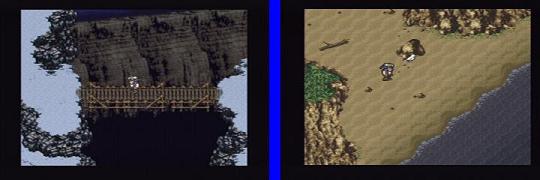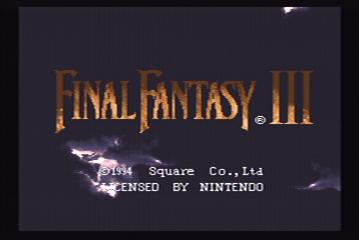

The Final Fantasy series had taken a rather involved route up to this point. It originally started with the Famicom and NES game Final Fantasy, which served as a huge boost to Square, giving the company a solid foundation to start working with. They certainly took advantage of it, releasing Final Fantasy 2 and 3 for Famicom soon after. These games, unfortunately, were only released in Japan then, and didn't make their way over to the NES. With Final Fantasy 4 for Super Famicom, the series finally made its way back over to the US, as Final Fantasy 2 for SNES. After that, however, Final Fantasy 5 for Super Famicom didn't make its way out for the SNES, leaving another gap in the series. With Final Fantasy 6, however, many of the best elements were mixed together into a wonderful game which, fortunately, did make its way over to the US as well, as Final Fantasy 3 for SNES.
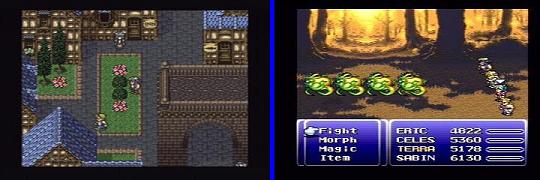
The game starts off, after a brief introduction, by dropping right into the middle of the action, with an unnamed girl being controlled by two soldiers, all fighting in mechanical armor, marching their way through a small village searching for something. Soon after this rather strange beginning, the girl is freed from their control and is rescued by another character and ends up in a house, in a more friendly situation, and things are explained a bit more. It seems that, 1000 years ago a war had broken out over the power of Magic, which caused a great deal of destruction and other problems, and so Magic was locked away out of the reach of humans, and things became more peaceful. As is often the case, peace isn't going to last for long, and now some people in control, "The Empire," are trying to rediscover Magic for their own uses. The girl who had started off the game appears to be the key to uncovering the secrets, and was being used by them for this goal. The people who have rescued her are on the other end of this issue, trying to stop the Empire from bringing back Magic, and all the destructions and problems that had went along with it.
This is how the initial group of people ends up coming together. Throughout the course of the game, however, numerous other people will be added to the party, each with their own backgrounds, stories, and reasons for getting involved in this whole ordeal. At any given time the active party is only going to consist of a maximum of four people, but, one will gain control of more than a dozen people who can be selected, depending on the situation, to make up the party. The basic play of the game is a straightforward turn-based RPG with random encounters, like previous ones in the series and many other RPGs. As one wanders around the world, through caves or castles or many other places, randomly an enemy will engage a battle. In the battle, the characters have a gauge which will fill up, at which point they can attack, by choosing from a number of different attack options, such as a normal attack, a magic attack, or some other special skills depending on the character. After the battle, characters will get experience, which leads to gaining levels and advancing in statistics, and gold which can be used to buy weapons, armor, items, and other useful things. There is a bit more involved as well, which will be discussed in a moment. For the most part though, the basic play of the game is fairly similar to many other RPGs that one may have played.
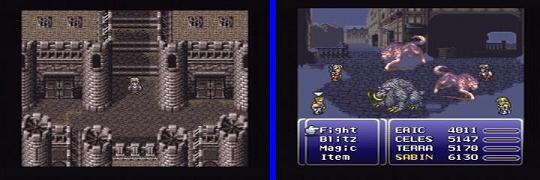
A notable thing about character growth, however, is how characters can gain magic. This is in a similar idea to what had been done with the Crystals in Final Fantasy 5 for Super Famicom, but, of course, with that not having made its way over for the SNES at the time, this was a new look at things. At a particular point in the game due to certain events within the storyline, one will begin to gain pieces of "Magicite." These Magicite come in a number of different forms, each with its own unique properties. The most significant aspect of them is, each character can "equip" a piece of Magicite, and each piece has different spells and multipliers associated with it. For instance, a piece may say "Bolt x10, Bolt2 x2, Poison x5." After a battle, points will be earned, which will be distributed toward these different spells. If an enemy gave 3 points, for instance, the character would be 30% of the way to learning Bolt, 6% of the way toward learning Bolt2, and 15% of the way to learning Poison. Every character can equip any piece of Magicite they want, which means that one can create a party with any arrangement of spells desired. Being able to put any piece on any character, and for everything adding together once it's learned, as opposed to needing to select what to be using as Final Fantasy 5 had done, does toward the end often lead to many of the characters - or the ones being used most of the time at least - having fairly similar abilities and being able to do most everything, which does make things easier. Still, being able to customize the characters like this makes things pretty interesting, giving a reason to go through battles aside from just experience. In addition to learning spells from the pieces of Magicite, each of them has a particular bonus if equipped when gaining a level; for instance, +1 to Stamina or +10% to HP. So, that will come into play as well, looking at when a character will level and deciding which piece to have on them for when they level.
As noted previously, after starting off the game with just a couple of characters for the party, along the course of the journey a number more characters will be added to the group. Some will come fairly soon, while others won't join until much later along in the story. Unlike some other games with many characters where many of them feel generic and just added in to bring up the total, however, almost none of the characters here feel tacked-on, and all of them have a very compelling story behind who they are, what they are doing, and why they are in this gathering. Most characters are added by playing through a certain segment of story which relates directly to them and how they're being added to the group, and a number of them have specific events which transpire later in the game which are focused on them as well. In addition to that, depending on the characters in the party at a given time or during a certain occurrence, one will often see different dialog or have slightly different things take place, where different things might have happened had the party arrangement been different. As noted above all of the characters can learn all of the magic in the game, but, many of the characters have a particular skill or ability which is unique to them as well, which still serves to set apart the different members as helpful to the group for their own particular reason. Simply playing through multiple times using different members when possible can give things a whole new look and feel.
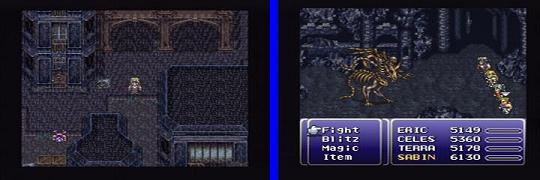
In addition to the stories involved in getting all of these characters into the group, the overarching storylines within the game are absolutely spectacular as well. One definitely doesn't feel as if just going from place to place for no apparent reason, but instead feeling a direct and specific reason for doing what needs to be done at any given time, and a desire to accomplish it based on what it will cause to happen. The direct passage of one event into another continues through much of the game, but, later on due to some things which take place, toward the end there will be the option to do things in a number of different orders, or even not do some things if one chooses not to do them and just go and beat the game. As well, there will be a mode of transportation which makes it possible to go to any place at any time, as opposed to having to walk around with most things being in a direct or logical path from one another. This open-endedness does make things seem a bit loose toward the end, but, having options of different places to go can be nice as well. Not to mention, the individual stories that go along with all the different pieces are still as well done as the rest of the story - just that it's not in a set order with it being necessary to do everything. One can choose to beat the game without doing most of these, not only does the extra experience and other things gained from going through all of these places make the final area much easier, but, it is definitely interesting to see all the different things going on as well.
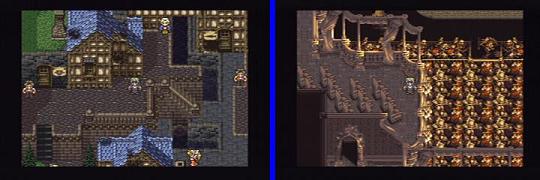
During the course of the journey, the adventurers will pass through a wide variety of different areas, which are not only very interesting to explore, but also look very nice as well. In battles, there are different backgrounds depending on the type of land on which one had encountered the enemy, and while the focus is of course on the actual battle itself, the backgrounds serve to make for a perfect backdrop for the battles. They definitely help to give the feeling that one is really wandering through a desert, as a battle rages among the trees, or trekking through a desert as wind-swept sand dunes surround the fight. While walking around exploring, there are a wide variety of areas to pass through, each with its own unique look and feel. As well, every area is finely laid with details. There are slivers of light, colorful sunsets, broken stones, cascading waterfalls, furnished houses, and all sorts of other intricate touches. While doing all of this wandering around and exploring, there is also a wonderful musical arrangement playing for each of places. Each area has its own particular music, which always fits it perfectly, and helps to draw one into the surroundings and the game. One could easily sit there for a while listening to the music, before remembering that one should be doing something as well.
The game is fairly lengthy, even if one doesn't choose to do everything there is available to do and skips along as quick as possible. At least around 40 hours would be a good estimate on things, and longer if one is taking their time. After having gone through the game once, there are definitely a number of reasons to go through it multiple times after that. Of course, the best reason is that it's a spectacular game, and so much fun to play that one will want to do it again just because of that. Then, there is the fact that it's not necessary to do everything there is to do at the end before beating it, so one could go through making sure to do everything there is to do. Even beyond the more obvious major things there are to do, there are also smaller goals such as getting all the abilities of certain characters, or finding hidden items or little side goals that are available to do. As well, simply playing through the game using a different arrangement of characters can really give the whole thing a completely new feel to it; not just for the different abilities the different characters have, but for the different dialog and scenes one might see along the way. Still, the best reason comes back to the fact that it's simply a fun game, with so much to do, that one will want to do it again just because of how enjoyable it is.
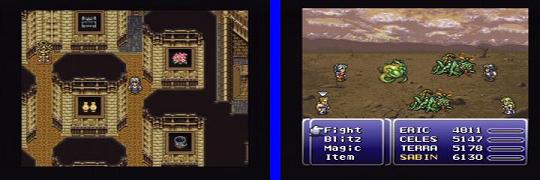
Of course, if one isn't a fan of RPGs in general, this probably isn't the sort of game one would find appealing. It still does have that base of random encounters and turn-based battles (although with the meter to make things a bit more interesting, but still no moving around or any of that stuff) that form the core of the gameplay. If one isn't the sort of person who finds that sort of thing to be interesting, there really isn't any getting around it. For anyone who is a fan or RPGs, however, this is certainly one of the best, and many would argue the best, out there. It's part of a great series in general, and if one has enjoyed other games in the series but hasn't played this yet, it's definitely something to check out. If one has enjoyed other RPGs and hasn't had the chance to try the series yet, this is certainly as good a place as any to start in on it. An absolutely spectacular game, which mixes together many of the best elements of the previous games in the series and many new things of its own, to come out with what still shines today as one of the most remarkable games ever.
